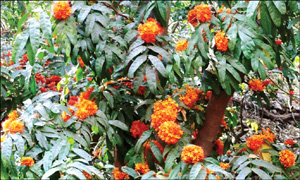by Dr. Mahadeswara Swamy, Scientist, Mob: 97429-91057, e-mail: swamy_clri@hotmail.com
Ashoka’ or ‘Sita Ashoka,’ one of the most beautiful indigenous trees, looks marvellous when fragrant, pale apricot (scarlet) Ixora like blooms are fashioned amidst the deep green shiny foliage. It is a sacred tree for Hindus and Buddhists. Therefore, it is widely grown in gardens adjoining temples and monasteries. According to one belief, Lord Buddha was born under an ‘Ashoka tree.’ According to Ramayana, it is associated with chastity. Sita, after being abducted by Ravana, spent her days grieving for Rama in Ashoka Vana. A quaint Hindu belief is that the tree will flower only in places trodden upon by a woman’s foot!
In West Bengal, women eat the flower buds on ‘Ashoka Shanthi’ day. The scientific name is ‘Saraca asoca’ belonging to Fabaceae (pea family). ‘Saraca’ is derived from Western Indian vernacular name for the tree; ‘asoca’ means ‘sorrow – less’ in Sanskrit. It is native to India, Sri Lanka, Burma and Malaysia. It is found wild in forests of Khasia Hills in Assam and Western Ghats and grown all over India.
It is a medium-sized, evergreen, hardy tree with erect trunk, rounded crown and drooping foliage. The bark is distinguished by the presence of warty protuberances on its outer surface. The compound leaves are arranged alternately on the stem; leaflets, 3-6 pairs, opposite, deep green, elliptic oblong in shape with wavy edges; surface is glabrous and shiny.
Young leaves are coppery red and flaccid — the distinguishing feature. Large clusters of golden yellow fragrant flowers appear on trunks and old branches, 4-6” across. The flowers have no petals and the sepals form a tube at the base and open up into 4-6 petal like lobes, first orange and later turn to scarlet. The stamens are orange near the base and scarlet upwards.
The fruit is a dehiscent pod with 4 to 8 seeds. They are fleshy and red when young and closely resemble the young tamarind pods.
Uses: The tree has immense medicinal value. The bark is astringent and used in uterine infections, menorrhagia (scant menses), dysmenorrheal (painful menses, menstrual cramps), leucorrhoea, as a uterine sedative and tonic. The bark powder is also used for improving skin complexion. The flowers are used in diabetes and dysentery. Seeds are chewed as a substitute for betel-nuts. Ayurvedic medicines ‘Ashokarishtam’, ‘Ashoka Ghrita’ and ‘Chandranadi Thailam’ contain ingredients from this tree. The timber is used for house building in Sri Lanka.
Other related species: S. cauliflora: Yellow and orange flowers (yellow turning red) on thin woody branches, but not on trunks; S.declinata (red asoca): Large clusters of red flowers on old branches and twigs; S.thaipingensis (yellow saraca): Large clusters of golden yellow flowers on trunks and old branches.
Note: Polyalthia longifolia is often planted in many places in the name of ‘Ashoka’ tree. This is a misnomer. At best, it can be labeled as ‘Madras Ashoka’ or ‘False Ashoka.’
Useful tips: Suitable for small avenues, parks, big gardens as well as home gardens.
Prefers shady situation and a porous, moist soil.
Needs shelter from dry wind in hot places.
Easily propagated from seeds.
Looks beautiful when planted in the corner of a lawn.
Peak flowering season: February to June.
This beautiful tree can be seen in Curzon Park, park adjacent to B.M. Hospital on Hunsur Road and many other places.
source: http://www.starofmysore.com / Star of Mysore / Home> Feature Articles / Sunday – June 14th, 2015
